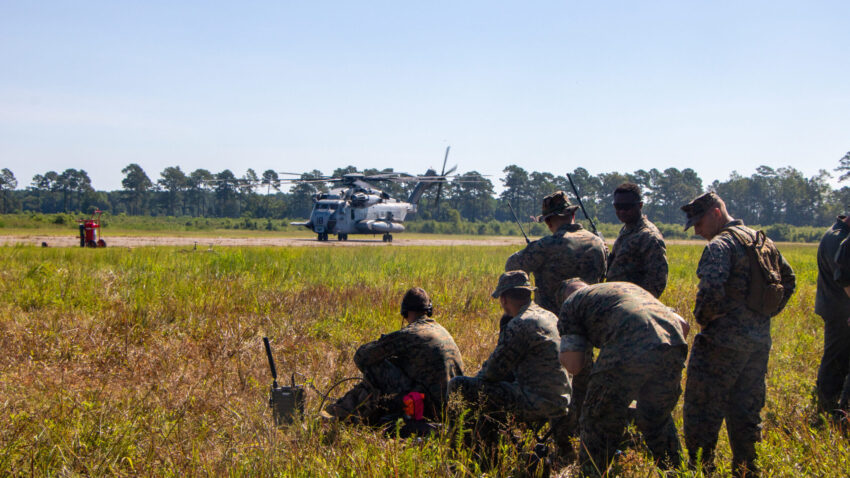Marines with Combat Logistics Regiment 2 watch as a CH-53E helicopter lands near their expeditionary base located several miles away from Cherry Point, N.C., during Large Scale Exercise 2023. (Justin Katz/ Breaking Defense.)
NORFOLK, Va. — The US Navy’s global maritime exercise this year will for the first time include participants from Canada, Japan and NATO, as service leadership aims to force the fleet to practice communicating both up and down the chain of command as well as with allies and partners.
Large Scale Exercise 2025, scheduled to take place later this summer, is the third iteration of the Navy’s global maritime exercise. Unlike other events, LSE is unique because it is a strictly naval exercise that strives to pressurize the entire fleet simultaneously in an effort to see where things fall apart if the Navy and Marine Corps were thrust into a global conflict.
Speaking to reporters on Monday at the headquarters of US Fleet Forces Command, senior officers leading this year’s exercise said planning began almost immediately after the 2023 event concluded.
“Our exercise control group is almost 900 people actually run this thing worldwide,” said Rear Adm. Kenneth Blackmon, the exercise’s director. “That’s assessors and exercise control, people simulating moving ships [and] things in the virtual and constructive environment.”
RELATED: Inside the Navy’s largest exercise: In command and under pressure
The officials did not disclose specifics of the exact scenario being presented to commanders.
Capt. Chris Narducci, the exercise’s lead planner, said LSE 2025 will include participants from all the Navy’s numbered fleets (2nd, 3rd, 4th, 5th, 6th, 7th and 10th) along with the three, four-star operational commands (Fleet Forces, Naval Forces Europe and Africa, and Pacific Fleet) as well as their Marine Corps counterparts.
The inclusion of NATO, Canadian and Japanese forces will be “replicated,” the officials said. That effectively means each country and NATO will provide staffers that role-play as the relevant officials that Americans commanders would have to communicate with in the context of the scenario. Similarly, the US Navy will have more than a dozen retired flag and general officers as well as American officials replicating orders and inputs from the secretary of defense, the combatant commanders and other leaders who would ultimately be communicating with the Navy and Marine Corps during a conflict.
However, Blackmon said the foreign countries and NATO would not be using live assets, such as planes or warships, during the exercise.
A key aspect of the Navy’s LSE events is the use of live, virtual and constructive forces. Live forces refer to ships, subs and planes physically present in their area of responsibility executing their assigned missions. A virtual asset is one that is simulated but not physically present, such as an enemy plane appearing on a ship’s radar. Constructive forces refer to real assets, such as a warship, that may not be present in the region but are participating remotely.
“What I think most people need to take away from this entire exercise is how hard it is,” said Brig. Gen. Thomas Armas, deputy commander of Fleet Marine Forces Atlantic. “Nothing is easy, and the sailors and Marines make this look easy. … This is very hard, and you lose the ability to do it quickly. So we have to maintain those reps and sets to ensure that we have this capability no matter where it is, no matter what the scenario.”
Click this link for the original source of this article.
Author: Justin Katz
This content is courtesy of, and owned and copyrighted by, https://breakingdefense.com and its author. This content is made available by use of the public RSS feed offered by the host site and is used for educational purposes only. If you are the author or represent the host site and would like this content removed now and in the future, please contact USSANews.com using the email address in the Contact page found in the website menu.








